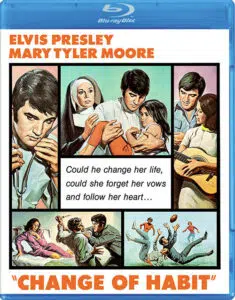
Some films attract our attention because they’re especially well-made or did big business or won awards or something along those lines. Others call out to us as artifacts that reveal something about their era, perhaps more than its makers thought about.
Into this second category falls Change of Habit (1969), one of several features helmed by prolific television director William A. Graham. The film, newly remastered on Blu-ray by Kino Lorber, stakes its claim to fame as Elvis Presley’s last film and also the last of Mary Tyler Moore’s four Universal features before she went back to television and made history with the long-running The Mary Tyler Moore Show (1970-77).
It’s easy to make fun of Change of Habit and many have. What’s more rewarding is anatomizing the film as a message from the last moments of the 1960s and the dawn of the ’70s – the same year Elvis released “In the Ghetto”. The film now interests us as a social mirror, not so much of “reality” but of how Hollywood depicted such a concept.
Foremost, Change of Habit was conceived as a product for mainstream entertainment, not a milestone in socially conscious drama. So one thing we learn about Hollywood at the dawn of New American Cinema is that even in an Elvis Presley film all bets were off, or at least that it was thought viable to construct entertainment that made “statements” about contemporary social problems while attempting to be “hip” and “tell it like it is.”
The film opens with nuns at prayer. The Mother Superior (Leora Dana) announces that Sister Michelle (Moore) will be sallying forth from the convent on a mission with Sister Barbara (Jane Elliott) and Sister Irene (Barbara McNair). As Presley’s rendition of the title song kicks in, with its lyrics about learning and changing your point of view, the snazzy editing cuts from a zoom on a crucifix to a low-angle shot of a traffic cop with his arms stretched across the screen: the spiritual to the mundane and the spiritual in the mundane.
The women’s visual association with the uniformed cop implies various meanings as he “shepherds” the crowd and declares himself the only one with the authority to stop traffic. Also, the whole scene is about uniforms and uniformity.
Filmmaker and academic Howard S. Berger calls the Christ/cop moment a jump-cut worthy of Ken Russell. He also describes the montage’s “striptease” of the nuns doffing nunly attire in favor of blouses, skirts, and nylon hose as taking off one uniform and putting on another. Berger and film writer Nathaniel Thompson will make other such social observations in their commentary, for the film’s busy and occasionally wrong-headed sociology is now its richest element.
As one handy index of social evolution, consider that under the MPAA’s recently inaugurated rating system, Change of Habit received a G rating. This is “family fare”, as Variety‘s October 1969 review labeled it, that opens with Presley’s character assuming that one of the three nuns must be wanting an abortion. After that little stunner, it moves on to other people’s dialogue tossing out at least three derogatory terms best not repeated here and then wraps things up with attempted rape. But hey, it’s Elvis and Mary Tyler Moore!
For comparison, consider that this is the same year Henry Hathaway‘s True Grit, also highly popular with families, received a G rating for a story loaded with corpses while John Wayne shouts lines such as “Fill yore hands, you son of a bitch!” Yes, 1969 was a different planet.
Getting back to the sequence in Change of Habit with the newly mufti-d nuns sashaying down the street, Sister Michelle gabbles out exposition that the Church is trying an outreach project where they gain people’s trust by deceiving them about their nunhood. If that sounds odd, and it hella does, let’s say they’re trying to gain trust by not instantly signaling their vocation.
In this way, the film is picking up on the habit (ahem) or convention of Sisters not wearing the black and white costume with a veil. This choice is a sign of social evolution sometimes greeted with controversy. Most cinematic nuns would persist in the instantly identifiable uniform, even after most Sisters in life stopped doing so.
For the record, “nuns” are women who live in cloisters while those who minister in the world are “Sisters” rather than nuns. If this film is being technically correct, its trio is emerging from a cloistered, contemplative life to work in the world as a kind of adjunct or experiment, as ordered by their diocese, or perhaps as inspired by Maria (Julie Andrews) in Robert Wise’s 1965 film, The Sound of Music. That said, we can’t be entirely sure if the filmmakers are alert to the distinction.
So our nunly trio arrive at the free clinic in a neighborhood of ethnically mixed population. There are African-Americans, such as the Black Panther played by Ji-Tu Cumbuka in black sunglasses, who proudly call themselves “Black” as distinct from “Negro”, which is Sister Irene’s term for herself. So the politics of evolving nomenclature is alluded to in fraught dialogues, with the added ecumenical play on the term “sister”.
There are Anglo characters such as the two persnickety elderly ladies, Lily (Ruth McDevitt) and Rose (Doro Merande), who for some reason share a brownstone. Are they sisters? We know only that they think the worst of everyone and live in one continual sniff of disapproval. Rose can’t help observing of the Sisters, whom they assume to be prostitutes, that “one of them is as black as the ace of spades.” The old ladies are Catholics, but Sister Michelle quips, “Too bad they’re not Christians.”


